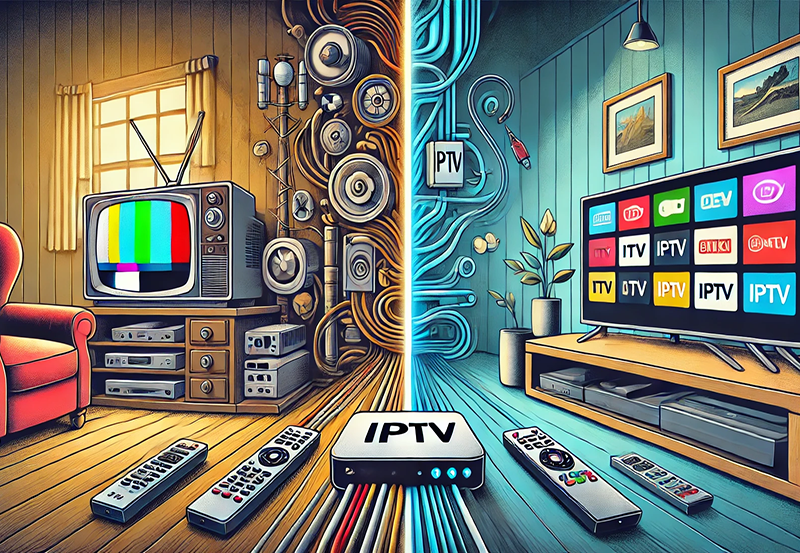IPTV, or Internet Protocol Television, is a technology that delivers television content over the internet rather than through traditional cable or satellite means. This allows for a more interactive and personalized viewing experience, as well as the ability to access a wider range of content from around the world. IPTV has had a significant impact on connectivity, as it requires a stable and high-speed internet connection to deliver high-quality video and audio content to viewers.
This means that the performance of IPTV is heavily reliant on the quality and reliability of the internet connection, as well as the settings and configurations of the devices and networks involved. IPTV has revolutionized the way we consume television content, offering a more flexible and customizable viewing experience. With IPTV, viewers can access a wide range of channels and on-demand content from various devices, including smart TVs, computers, smartphones, and tablets.
This has led to an increased demand for high-speed internet connections and improved network infrastructure to support the growing popularity of IPTV services. As a result, understanding the impact of IPTV on connectivity is crucial for both consumers and service providers to ensure a seamless and enjoyable viewing experience.
Key Takeaways
- IPTV (Internet Protocol Television) is a technology that delivers television content over the internet, impacting connectivity by requiring a stable and high-speed internet connection.
- DNS (Domain Name System) settings play a crucial role in improving IPTV connectivity by translating domain names into IP addresses, reducing latency and improving network performance.
- Configuring router settings for optimal IPTV performance involves prioritizing IPTV traffic, enabling Quality of Service (QoS) settings, and ensuring sufficient bandwidth for seamless streaming.
- Firewall settings are important for IPTV connectivity as they can block or allow specific traffic, ensuring the security of the network while allowing IPTV content to be delivered without interruptions.
- DHCP (Dynamic Host Configuration Protocol) settings can enhance IPTV experience by automatically assigning IP addresses to devices on the network, simplifying network management and ensuring seamless connectivity for IPTV services.
- NAT (Network Address Translation) settings impact IPTV connectivity by allowing multiple devices to share a single public IP address, enabling efficient use of IP addresses and improving network security for IPTV services.
- Troubleshooting common connectivity issues with IPTV and DNS settings involves checking internet connection, verifying DNS settings, ensuring router configurations are correct, and addressing any firewall or NAT issues that may be impacting IPTV performance.
The Role of DNS Settings in Improving IPTV Connectivity
Using a Reliable and Fast DNS Server
One way to improve IPTV connectivity through DNS settings is by using a reliable and fast DNS server. Many internet service providers offer their own DNS servers, but these may not always be the fastest or most reliable option. By switching to a third-party DNS server, such as Google DNS or OpenDNS, users can often experience faster response times and improved overall performance when accessing IPTV services.
Configuring DNS Settings for IPv6
Additionally, configuring DNS settings to use IPv6, the latest version of the internet protocol, can also help improve connectivity for IPTV by providing a more efficient and scalable network infrastructure.
Optimizing DNS Settings for a Seamless IPTV Experience
By optimizing DNS settings, users can ensure a seamless and reliable IPTV experience. With the right DNS settings, users can enjoy high-quality IPTV content without interruptions or buffering, making it an essential step in ensuring a smooth and enjoyable viewing experience.
Configuring Router Settings for Optimal IPTV Performance
The router is a critical component of any home network, serving as the gateway between devices within the network and the internet. When it comes to IPTV connectivity, configuring router settings is essential for ensuring optimal performance and reliability. One important aspect of router configuration for IPTV is Quality of Service (QoS) settings, which prioritize network traffic to ensure that IPTV content is given the highest priority for smooth streaming without interruptions or delays.
In addition to QoS settings, users can also optimize their router settings for IPTV performance by ensuring that the router firmware is up to date. Manufacturers often release firmware updates to address security vulnerabilities and improve overall performance, so keeping the router firmware updated is crucial for maintaining a stable and secure network environment for IPTV streaming. Furthermore, users can also consider using wired connections instead of Wi-Fi for devices that are used for IPTV streaming, as wired connections typically offer more reliable and consistent performance compared to wireless connections.
The Importance of Firewall Settings for IPTV Connectivity
Firewalls are essential for protecting home networks from unauthorized access and potential security threats. However, they can also impact IPTV connectivity if not configured properly. When it comes to IPTV, firewall settings play a crucial role in ensuring that network traffic related to IPTV services is allowed to pass through without interference, while still maintaining a secure network environment.
One way to optimize firewall settings for IPTV connectivity is by creating specific rules or exceptions for IPTV traffic. This can involve opening specific ports or allowing traffic from certain IP addresses associated with IPTV services to pass through the firewall without being blocked. Additionally, users can also consider using application layer gateways (ALGs) or stateful packet inspection (SPI) features in their firewall settings to better manage and control IPTV traffic while maintaining network security.
How DHCP Settings Can Enhance IPTV Experience
Dynamic Host Configuration Protocol (DHCP) is a network management protocol that automatically assigns IP addresses and other network configuration settings to devices within a network. When it comes to enhancing the IPTV experience, DHCP settings can play a significant role in ensuring that devices have the necessary network configurations to support smooth and reliable streaming of IPTV content. One way to enhance the IPTV experience through DHCP settings is by configuring DHCP reservations for devices used for IPTV streaming.
This ensures that these devices always receive the same IP address from the DHCP server, which can help prevent connectivity issues and simplify network management. Additionally, users can also consider adjusting DHCP lease times to ensure that devices maintain consistent network connectivity without experiencing interruptions or disconnections while streaming IPTV content.
NAT Settings and Their Impact on IPTV Connectivity
Understanding the Importance of NAT Settings
Configuring NAT settings properly is vital for ensuring that IPTV traffic can pass through the network without being blocked or encountering connectivity issues. Improper NAT settings can lead to connectivity problems, making it essential to optimize them for seamless IPTV connectivity.
Optimizing NAT Settings for IPTV Connectivity
One way to optimize NAT settings for IPTV connectivity is by enabling UPnP (Universal Plug and Play) on the router. UPnP allows devices within the network to automatically configure port forwarding and other NAT settings as needed, which can help ensure that IPTV traffic is able to pass through the network without requiring manual configuration.
Manual Port Forwarding for IPTV Services
Additionally, users can also consider setting up port forwarding rules manually for specific ports used by IPTV services to ensure that traffic is directed to the appropriate devices within the network. This approach provides more control over NAT settings and can be useful in scenarios where UPnP is not supported or enabled.
Despite best efforts in configuring network settings for optimal IPTV connectivity, users may still encounter common connectivity issues that can impact their viewing experience. Some common issues related to DNS settings include slow response times when accessing IPTV services, difficulty resolving domain names for IPTV servers, or intermittent connectivity problems while streaming content. To troubleshoot these issues, users can start by checking their DNS settings to ensure that they are configured correctly and using reliable DNS servers.
Switching to alternative DNS servers or using tools such as DNS benchmarking utilities can help identify faster and more reliable DNS servers for improved performance. Additionally, users can also consider clearing their DNS cache or resetting their DNS settings to default values to resolve any potential issues related to DNS configuration. In conclusion, understanding the impact of IPTV on connectivity and optimizing network settings such as DNS, router configurations, firewall settings, DHCP, NAT, and troubleshooting common connectivity issues are essential for ensuring a seamless and enjoyable viewing experience with IPTV services.
By taking proactive steps to configure and manage these settings effectively, users can enhance the performance and reliability of their home networks for streaming high-quality IPTV content without interruptions or connectivity issues.
If you’re looking to improve your IPTV connectivity, you may also be interested in learning how to set up IPTV on Apple TV. This article from SmartTVIPTV.click provides a comprehensive guide on what Apple TV is and how to set up IPTV on this device. Check it out here.





